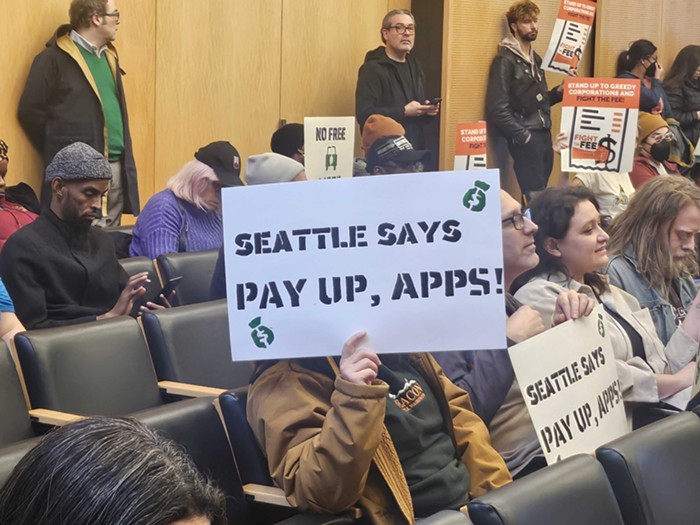People wince nervously, or cough and change the subject. It's not, I think, just that the idea has the icky tint of unshaven legs and goddess painting. It's simply because the proposition is full of contradictions. For every generalization--no matter how well informed--there is an exception, either in degree or theory. There are those who find humor trivializing and those who find it utterly necessary. There is the loaded question of how the gender of the artist directs perception of the work: Why are Balthus' little girls considered scandalous while Lisa Yuskavage's busty blondes are taken for witty and a little sad? If a woman had created enormous canvases of smashed plates--literally deconstructing a domestic symbol--would it have been interpreted differently from Julian Schnabel's version? Would she have been as successful and rich?
And then there is the postmodern legacy of definitions careening out of control. Art is no longer limited to Clement Greenberg's conception of artists (specifically men) laying paint on surface, but can include art's formerly sidelined cousins: conceptual art and performance, crafts, graphic and industrial design, fashion. Feminism, too, has changed. The prevailing forces of the '70s and '80s that made it exclusive to those who had done the required reading have given way to a more generous (if less coherent) movement: sex-positive feminism, girl-power feminism, an oblivious feminism born of a happy sense of entitlement. Young women go forward as if they deserve everything that men deserve, and they often get it. Doubtless some of them would not call themselves feminists, but the default position looks a great deal like something Gloria Steinem would approve of.
The trajectory of feminist art parallels that of the movement, from consciousness-raising and women's lib toward something less prescribed. The tone of feminist art in the '70s was overwhelmingly set by Judy Chicago and Miriam Schapiro. Both women drew heavily, at times exclusively, on vaginal imagery to invoke womanhood and to identify their work as feminist. (The critic Lucy Lippard was inspired by Chicago to make her famous statement that it is the duty of women artists to make work that addresses social conditions rather than self expression; none of that self-indulgent personal crap, please!) Chicago's famous work, The Dinner Party (1979)--a triangular table set for mythic and historical women with 39 places, including flatware, chalice, napkin, and molded vaginal plate--carried an obvious message: Women deserve a place at the table.
There were women working in other modes, such as Yoko Ono's brilliant and continued tweaking of the male conceptual establishment; Lynda Benglis' famous ad, an image of the artist naked and holding an enormous dildo, in the November 1974 Artforum; Jenny Holzer's first Truisms. This is the work that paved the way for women's art in the '80s and '90s taking on transgression, sex, and censorship more bravely and more nonchalantly, as a fact of life rather than a politic that must be attended to. Kim Dingle's furious baby girls, the explicit performances of Karen Finley and porn-goddess Annie Sprinkle, Cindy Sherman's staged movie stills, Sophie Calle's identity games--all of these contain the seeds of Chicago, directing the viewer's gaze to something he would probably rather not see. At the same time they are something that Chicago's work was emphatically not, and that is funny.
Here, humor takes the place of ideology. In the catalogue accompanying the 1994 exhibition Bad Girls, co-curator Marcia Tanner notes that "the art looks... disarmingly humorous and as sensuously beguiling as a cake with a dagger baked inside." Bad Girls took humor as its guiding principle, and included work by artists with as diverse visions as Jeanne Dunning, Janine Antoni, Sylvie Fleury, and the Guerrilla Girls--these last being the high priestesses, and the most political, of women striking back at the male establishment.
Let's call it Girlie art--art that is fun and maybe a little giggly but that aims straight at the gut. It draws on the freedom and mystery and distress of growing up a girl; it doesn't follow the rules. Now, this town doesn't have an overwhelming (or even barely perceptible) strain of political art, but Girlie art is in strong evidence in the work of artists such as Nicola Vruwink, Jennifer McNeely, and Siobhan Arnold. Vruwink works in a variety of media, almost never with the results that you would expect. She paints with Kool-Aid, draws with sugar, builds mosaics out of marshmallows, and tats doilies with Easter-basket grass, perpetually challenging received ideas about sweetness, artifice, and immediate gratification. She paints sports trophies with pink nail polish and puts them on beds of pink satin pillows, revealing the delicate eroticism of the object.
McNeely and Arnold work at the opposite ends of a similar idea. McNeely's media of choice has been flesh-colored nylons stuffed with various materials, sewn into amorphous shapes and then bound with zippers or buttons, or sewn into suggestive crevices. I know a few men who are made distinctly uncomfortable by McNeely's work. Arnold, on the other hand, takes things apart, specifically women's shoes, deconstructing a male fetish object into a female-made one. The results have the air of other things-- a pair of pig's ears and a long sentence inscribed in black leather, strung together with laces and shown against an Elizabeth-Arden--pink wall--but they ultimately assert control over an item that some women feel control them.
These three artists are the subjects of a short documentary called Desire, by Cynthia Rose, a former Seattle Times art critic. As I watched the video, I began to see connections. All three transform everyday objects into art that raises questions about utility and perception. The art is the result of intense by-hand labor that contradicts the mass-market provenance of the materials. The artists don't ignore the connotations of these materials--of sweets, leather, and stockings--rather, they take control of the implied meanings and raise the level of discourse. The willingness to bring a humble pair of stockings into the conversation is evidence that humor, be it knee-slapping or uncomfortable, may be more instructive than finger-pointing.
So if you'll buy that Girlie art combines humor with craft and less-than-haughty materials, you'll begin to see that other artists around here are working in this vein. I'm thinking of Susan Robb drawing portraits on giant SweeTARTS, of Wendy Hanson stitching together rose petals, of Thess Fenner using surveillance to look at the ways we look at ourselves. I'm thinking of Leslie Clague's felt-and-wire corsets, of Mandy Greer's erotic animal tableaux, even of the Rollvulvas' rowdy burlesque.
Part of being a woman, as John Berger so famously noted, is having to carry around a mental image of yourself doing all the things you do all day long, as part of a spectacle for others. Girlie artists bring some of that spectacle to the relatively static world of visual art, a self-conscious brand of self-consciousness, a peaceful coexistence of irony and sincerity. If the terms of the feminist art argument have become more slippery, at least the conversation has become a lot more interesting, and laughing (thankfully!) is now permitted.


















